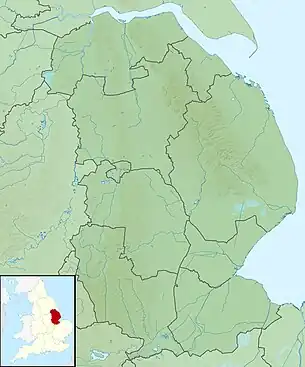| River Brant | |
|---|---|
 River Brant at Blackmoor bridge | |
| Location | |
| Country | United Kingdom |
| Country within the UK | England |
| Counties | Lincolnshire |
| District | North Kesteven, South Kesteven |
| Villages | Gelston, Brandon, Stragglethorpe, Brant Broughton |
| Physical characteristics | |
| Source | |
| • location | Gelston, Lincolnshire |
| • coordinates | 52°59′41″N 0°38′38″W / 52.9948°N 0.6438°W |
| • elevation | 60 m (200 ft) |
| Mouth | |
• location | River Witham near South Hykeham, Lincolnshire |
• coordinates | 53°09′44″N 0°34′38″W / 53.1623°N 0.5772°W |
• elevation | 5 m (16 ft) |
| Length | 23 km (14 mi)[1] |
| Basin size | 138 km2 (53 sq mi)[1] |
| Discharge | |
| • location | Brant Broughton[2] |
| • average | 0.24 m3/s (8.5 cu ft/s)[2] |
| Basin features | |
| Tributaries | |
| • left | Sand Beck, West Brant Syke |
| • right | The Beck |
| Progression : Brant — Witham — The Haven — North Sea | |
The River Brant is a 14 mi-long (23 km) tributary of the River Witham that flows entirely in the county of Lincolnshire, in the east of England.
In 1855 the River was described as follows;[3]
"Brant, a tributary of the Witham in the western part of the county of Lincoln. This small stream has its rise in several fine springs in the parish of Hough-on-the-Hill, and pursues its humble course in a northern direction, westward of a range of high land."
Name
The origin of the name is from the Old English; brant (meaning "steep", "deep"). Steep being a steeply sloping incline.[4]
Course
The Brant rises on the flank of Summerfields Hill to the south-west of Gelston near Hough-on-the-Hill and curves round such that it flows almost directly north, parallel to the Limestone Lincolnshire Edge. The river flows past Brandon to which it gives its name, then reaches Stragglethorpe where it is joined by The Beck, which drains Fulbeck. At Brant Broughton it meets with its largest tributary the Sand Beck, and then continues north passing the Low Fields of Navenby, Boothby Graffoe and Coleby where it flows to the west of the deserted medieval village of Skinnand and the remains of Somerton Castle. Further north it then reaches its confluence with the River Witham between the villages of Aubourn and South Hykeham.[5][6]
See also
References
- 1 2 "Water Framework Directive Surface Water Classification Status and Objectives 2012 csv files". Environment-agency.gov.uk. Archived from the original on 24 February 2014. Retrieved 7 April 2013.
- 1 2 "30033 - Brant at Brant Broughton". The National River Flow Archive. Centre for Ecology & Hydrology. Retrieved 4 May 2013.
- ↑ The Book of English Rivers: An Account of the Rivers of England and Wales, Particularizing Their Respective Courses, Their Most Striking Scenery, and the Chief Places of Interest on Their Banks, Samuel Lewis, p46,Original 1855, ISBN 9781108025492, accessed 5 May 2013
- ↑ "Brandon History". loveden.org.uk. Retrieved 7 May 2013.
- ↑ "Environment Agency What's in your Backyard". Environment Agency. Retrieved 5 May 2013.
- ↑ Ordnance Survey (2009). Lincoln & Newark-on-Trent. OS Landranger Map Series. Ordnance Survey. ISBN 9780319227213.
